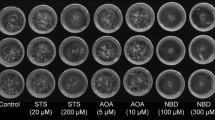Summary
The potential of colchicine and the microtubule depolymerizing herbicides trifluralin, oryzalin, and amiprophosmethyl (APM) for in vitro chromosome doubling during B. napus microspore culture was studied. Colchicine was administered during the first 6, 12 or 24 h of culture with 8 different concentrations up to 3 mM, and herbicides at 6 different concentrations up to 30 μM for 12 h.
Treatments with moderate concentrations of colchicine (3–100 μM) produced a small increase in embryo production, while concentrations above 300 μM were toxic. Colchicine treatment for 12 h resulted in higher embryo production than treatment for 6 and 24 h. Duration of treatment and concentration of colchicine both had a significant effect on the chromosome doubling. The highest diploidization rates (94% diploid regenerants) were seen after 24 h treatment with 1 mM colchicine.
All three herbicides were similar to colchicine in terms of their effect on embryo formation and chromosome doubling comparable to the one of colchicine, but at concentrations approximately 100 times lower. APM was less toxic than trifluralin and oryzalin, but no significant difference in chromosome doubling efficiency was detected between the compounds. The 12 h treatment resulted in a maximum of approximately 65% diploid regenerants with all three herbicides, but APM may have an advantage because of its less toxic effects. Prolonged treatment with APM (20–24 h) may produce 95–100% diploid regenerants.
Similar content being viewed by others
Abbreviations
- APM:
-
amiprophos methyl
- DMSO:
-
dimethyl sulfoxide
References
Bajer, A.S. & J., Mole-Bajer, 1986. Drugs with colchicine-like effects that specifically disasemble plant but not animal microtubules. Ann. New York Acad. Sci. 444: 767–784.
Brain, P. & R., Cousens, 1989. An equation to describe dose responses where there is a stimulation of growth at low doses. Weed Research 29: 93–96.
Chen, Z.Z., S., Snyder, Z.G., Fan & W.H., Loh, 1994. Efficient production of doubled haploid plants through chromosome doubling of isolated microspores in Brassica napus. Plant Breeding 113: 217–221.
Gamborg, O.L., R.A., Miller & K., Ojima, 1968. Nutrient requirements of suspension cultures of soybean root cells. Exp. Cell Res. 50: 151–158.
Iqbal, M.C.M., C., Möllers & G., Röbbelen, 1994. Increased Embryogenesis after Colchicine Treatment of Microspore Cultures of Brassica napus L. J. Plant Physiol. 143: 222–226.
Möllers, C., M.C.M., Iqbal & G., Röbbelen, 1994. Efficient production of doubled haploid Brassica napus plants by colchicine treatment of microspores. Euphytica 75: 94–104.
Morejohn, L.C. & D.E., Fosket, 1984. Inhibition of plant microtubule polymerization in vitro by the phosphoric amide herbicide Amiprophos-Methyl. Science 224: 224–226.
Morejohn, L.C., T.E., Bureau, T., Mole-Bajer, A.S., Bajer & D.E., Fosket, 1987. Oryzalin, a dinitroaniline herbicicde, binds to plant tubulin and inhibits microtubule polymerization in vitro. Planta 172: 252–264.
Pechan, P.M. & W.A., Keller, 1988. Identification of potentially embryogenic microspores in Brassica napus. Phys. Plant 74: 377–384.
Ramulu, R.S., H.A., Verhoeven & P., Dijkhuis, 1991. Mitotic blocking, micronucleation, and chromosome doubling by oryzalin, amiprophos-methyl, and colchicine in potato. Protoplasma 160: 65–71.
Swanson, E.B., 1990. Microspore Culture in Brassica. In: J.W. Pollard & J.M. Walker (Eds), Methods in Molecular Biology, vol 6, Plant Cell And Tissue Culture, Chap. 17.
Wan, Y., D.R., Duncan, A.L., Rayburn, J.F., Petolino & J.M., Widholm, 1991. The use of antimicrotubule herbicides for the production of doubled haploid plants from anther-derived maize callus. Theor. Appl. Genet. 81: 205–211.
Zaki, M.A.M. & H., Dickinson, 1991. Microspore-derived embryos in Brassica: The significance of division symmetry in pollen mitosis I to embryogenic development. Sex Plant Repro. 4: 48–55.
Zaki, M.A.M. & H., Dickinson, 1995. Modification of cell development in vitro: The effect of colchicine on anther and isolated microspore culture in Brassica napus. Plant Cell Tissue Organ Culture 40: 255–270.
Author information
Authors and Affiliations
Rights and permissions
About this article
Cite this article
Hansen, N.J.P., Andersen, S.B. In vitro chromosome doubling potential of colchicine, oryzalin, trifluralin, and APM in Brassica napus microspore culture. Euphytica 88, 159–164 (1996). https://doi.org/10.1007/BF00032447
Received:
Accepted:
Issue Date:
DOI: https://doi.org/10.1007/BF00032447




